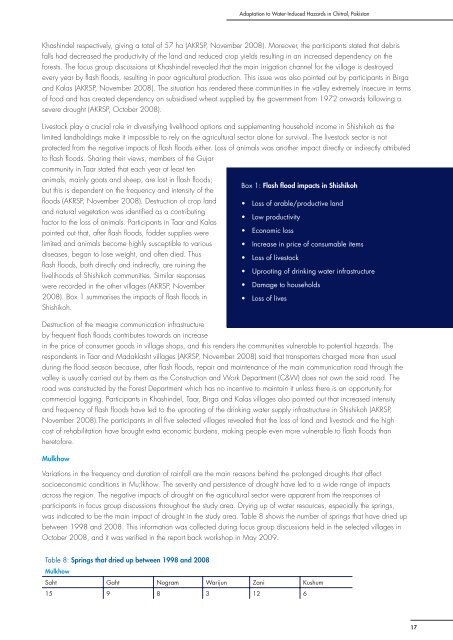Full Document - Himalayan Document Centre - icimod
Full Document - Himalayan Document Centre - icimod
Full Document - Himalayan Document Centre - icimod
You also want an ePaper? Increase the reach of your titles
YUMPU automatically turns print PDFs into web optimized ePapers that Google loves.
Adaptation to Water-Induced Hazards in Chitral, PakistanKhashindel respectively, giving a total of 57 ha (AKRSP, November 2008). Moreover, the participants stated that debrisfalls had decreased the productivity of the land and reduced crop yields resulting in an increased dependency on theforests. The focus group discussions at Khashindel revealed that the main irrigation channel for the village is destroyedevery year by fl ash fl oods, resulting in poor agricultural production. This issue was also pointed out by participants in Birgaand Kalas (AKRSP, November 2008). The situation has rendered these communities in the valley extremely insecure in termsof food and has created dependency on subsidised wheat supplied by the government from 1972 onwards following asevere drought (AKRSP, October 2008).Livestock play a crucial role in diversifying livelihood options and supplementing household income in Shishikoh as thelimited landholdings make it impossible to rely on the agricultural sector alone for survival. The livestock sector is notprotected from the negative impacts of fl ash fl oods either. Loss of animals was another impact directly or indirectly attributedto fl ash fl oods. Sharing their views, members of the Gujarcommunity in Taar stated that each year at least tenanimals, mainly goats and sheep, are lost in fl ash fl oods;Box 1: Flash flood impacts in Shishikohbut this is dependent on the frequency and intensity of thefl oods (AKRSP, November 2008). Destruction of crop land • Loss of arable/productive landand natural vegetation was identifi ed as a contributing• Low productivityfactor to the loss of animals. Participants in Taar and Kalaspointed out that, after fl ash fl oods, fodder supplies were • Economic losslimited and animals become highly susceptible to various • Increase in price of consumable itemsdiseases, began to lose weight, and often died. Thus• Loss of livestockfl ash fl oods, both directly and indirectly, are ruining the• Uprooting of drinking water infrastructurelivelihoods of Shishikoh communities. Similar responseswere recorded in the other villages (AKRSP, November• Damage to households2008). Box 1 summarises the impacts of fl ash fl oods in• Loss of livesShishikoh.Destruction of the meagre communication infrastructureby frequent fl ash fl oods contributes towards an increasein the price of consumer goods in village shops, and this renders the communities vulnerable to potential hazards. Therespondents in Taar and Madaklasht villages (AKRSP, November 2008) said that transporters charged more than usualduring the fl ood season because, after fl ash fl oods, repair and maintenance of the main communication road through thevalley is usually carried out by them as the Construction and Work Department (C&W) does not own the said road. Theroad was constructed by the Forest Department which has no incentive to maintain it unless there is an opportunity forcommercial logging. Participants in Khashindel, Taar, Birga and Kalas villages also pointed out that increased intensityand frequency of fl ash fl oods have led to the uprooting of the drinking water supply infrastructure in Shishikoh (AKRSP,November 2008).The participants in all fi ve selected villages revealed that the loss of land and livestock and the highcost of rehabilitation have brought extra economic burdens, making people even more vulnerable to fl ash fl oods thanheretofore.MulkhowVariations in the frequency and duration of rainfall are the main reasons behind the prolonged droughts that affectsocioeconomic conditions in Mu;lkhow. The severity and persistence of drought have led to a wide range of impactsacross the region. The negative impacts of drought on the agricultural sector were apparent from the responses ofparticipants in focus group discussions throughout the study area. Drying up of water resources, especially the springs,was indicated to be the main impact of drought in the study area. Table 8 shows the number of springs that have dried upbetween 1998 and 2008. This information was collected during focus group discussions held in the selected villages inOctober 2008, and it was verifi ed in the report back workshop in May 2009.Table 8: Springs that dried up between 1998 and 2008MulkhowSaht Gaht Nogram Warijun Zani Kushum15 9 8 3 12 617
















